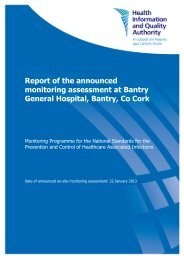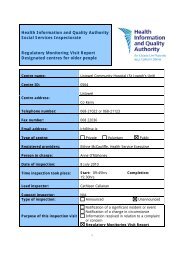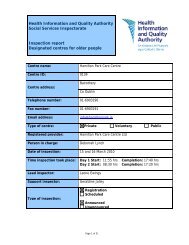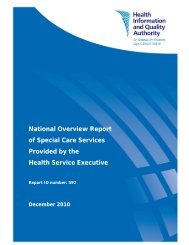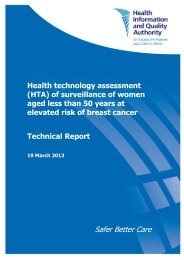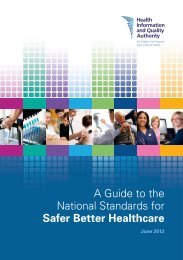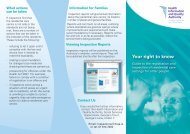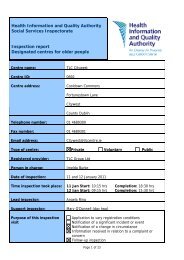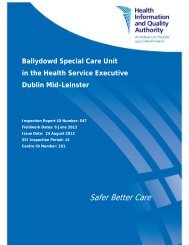EPrescribing and Electronic Transfer of Prescriptions - hiqa.ie
EPrescribing and Electronic Transfer of Prescriptions - hiqa.ie
EPrescribing and Electronic Transfer of Prescriptions - hiqa.ie
You also want an ePaper? Increase the reach of your titles
YUMPU automatically turns print PDFs into web optimized ePapers that Google loves.
<strong>EPrescribing</strong> <strong>and</strong> <strong>Electronic</strong> <strong>Transfer</strong> <strong>of</strong> <strong>Prescriptions</strong>: an International Rev<strong>ie</strong>wHealth Information <strong>and</strong> Quality Authority(Deliver, operationalise <strong>and</strong> enhance essential foundations required to enableeHealth).These dependenc<strong>ie</strong>s include:• Priority 1.1 Architecture <strong>and</strong> St<strong>and</strong>ards: NEHTA, in collaboration with St<strong>and</strong>ardsAustralia has developed <strong>Electronic</strong> <strong>Transfer</strong> <strong>of</strong> Prescription Messaging <strong>and</strong>Document St<strong>and</strong>ards.• Priority 1.2 National Healthcare Identif<strong>ie</strong>r Service: Healthcare Identif<strong>ie</strong>r Servicewent live in December 2010.• Priority 1.3 National Authentication Service for Health: The Department <strong>of</strong> HumanServices has launched an interim authentication service in 2012.• Priority 1.4 National Clinical Terminology <strong>and</strong> Information Service: SNOMED CTAU has been released (June 2010) the Australian Medicine Terminology (AMT)has been developed.• Priority 1.5 Secure Messaging: Technical specification published by St<strong>and</strong>ardsAustralia March 2010.• Priority 1.6 Security <strong>and</strong> Access to Health Information: National eHealthconformance, compliance <strong>and</strong> accreditations programmes options paper releasedfor public comment January 2010. Security <strong>and</strong> Access Framework initiated in2011.The Australian e-Medication Management programme solution is based on abarcoded paper prescription implemented in parallel with the transmission <strong>of</strong> anelectronic copy <strong>of</strong> the prescription to a central prescription exchange server, with thegoal <strong>of</strong> electronic only digitally signed prescriptions. This model was initially proposedin the Consultancy in <strong>Electronic</strong> Prescribing <strong>and</strong> Medicines in June 2008. (11)The draft <strong>Electronic</strong> <strong>Transfer</strong> <strong>of</strong> <strong>Prescriptions</strong> (ETP) specifications were released inOctober 2009 <strong>and</strong> following a period <strong>of</strong> consultation final specifications were releasedin 2010. (10)Three possible implementation levels have been identif<strong>ie</strong>d. ETP is designed tosupport a paperless process where prescriptions cross organisational boundar<strong>ie</strong>s, asin primary care, hospital or residential care settings.• ETP Level 1: Illustrated in Figure 1, this level describes the use <strong>of</strong> s<strong>of</strong>twareincorporating the ETP specifications to transfer an electronic copy <strong>of</strong> a paperprescription. This level allows healthcare providers <strong>and</strong> vendors to gainexper<strong>ie</strong>nce with the ETP process while retaining paper prescriptions. To supportthis level it is necessary to generate an electronic message containing all <strong>of</strong> theinformation on the prescription <strong>and</strong> also to print a NEHTA specif<strong>ie</strong>d DocumentAccess Key (DAK) barcode for each item on a paper prescription. The paperprescription remains the authoritative <strong>and</strong> legal document <strong>and</strong> is physically signedby the prescribing practitioner.8



